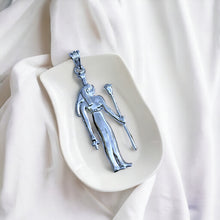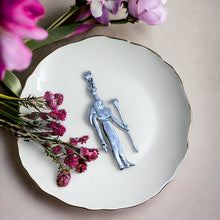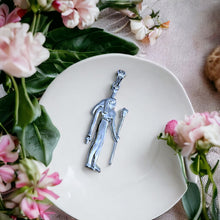The Silver Goddess Nyphthys Large Pendant Necklace: Inspired by ancient Egyptian mythology, this exquisite necklace features a large pendant depicting Nyphthys, the goddess of mourning and protection. Crafted with sterling silver, it pays homage to the rich cultural heritage and timeless elegance of Egypt.
- History: Inspired by ancient Egyptian mythology, particularly the goddess Nephthys.
- Spiritually: Represents protection, healing, and divine feminine energy.
- Talisman: Thought to bring luck, strength, and spiritual connection.
- Handmade: Crafted with care and attention to detail, each piece unique.
- Healing: Believed to promote emotional well-being and inner peace.
- Material: Sterling silver, known for its purity and elegance.
- Symbolism: Depicts the nurturing and protective aspects of the divine feminine.
- How to Wear: Hangs elegantly on any chain up to 5MM (0.2 inches) thick.
- Ideal Gift: Perfect for someone seeking spiritual guidance or a connection to ancient wisdom.
History Side For Those Who Are Interested
Nephthys, also spelled as Nephthys or Nebthet, is an ancient Egyptian goddess whose origins are deeply rooted in the mythology of the Nile Valley civilization. She is commonly depicted as a protective deity associated with mourning, funerary rituals, and the afterlife, serving as a companion to her sister Isis and often accompanying her in her roles as a divine mother and protector.
The earliest mentions of Nephthys date back to the Pyramid Texts of the Old Kingdom (circa 2686–2181 BCE), where she is described as the daughter of the primordial god Geb and the sky goddess Nut, making her a member of the Ennead, the pantheon of nine deities worshipped in Heliopolis. In these texts, she is often depicted as a loyal ally to her sister Isis, aiding her in her quest to revive Osiris, the god of the afterlife and fertility, after his murder by their brother Set.
Nephthys plays a pivotal role in the Osirian mythos, where she is sometimes portrayed as the wife of Set, who is both her brother and her rival. According to the myth, Nephthys disguises herself as Isis to seduce Osiris and conceive a child, Anubis, the jackal-headed god of mummification and the afterlife. Despite this deception, Nephthys remains loyal to her sister and assists her in the resurrection of Osiris.
Throughout Egyptian history, Nephthys continued to be venerated as a protective deity, particularly in funerary rites and in the rituals surrounding death and rebirth. She was often invoked alongside Isis, Osiris, and Anubis to provide guidance and protection to the deceased on their journey through the afterlife. In temple reliefs and funerary art, Nephthys is typically depicted as a woman with a hieroglyphic symbol of her name on her head, representing a temple enclosure flanked by falcon feathers.
As with many ancient Egyptian deities, the worship of Nephthys evolved over time, with her cult reaching its peak during the Late Period (circa 664–332 BCE) and the Ptolemaic period (332–30 BCE). Temples dedicated to Nephthys were erected throughout Egypt, and her influence extended beyond the Nile Valley to other regions of the ancient world, including Nubia and the Levant.
Despite the decline of traditional Egyptian religion following the spread of Christianity and Islam, the legacy of Nephthys endured through the preservation of her myths and iconography in ancient texts, temple reliefs, and burial artifacts. Today, she continues to be celebrated as a symbol of protection, mourning, and the eternal cycle of life and death in Egyptian mythology and popular culture.








